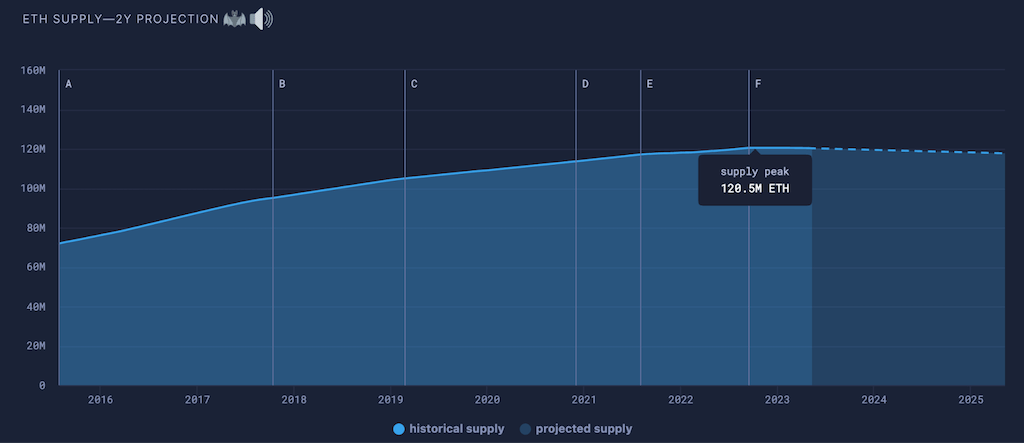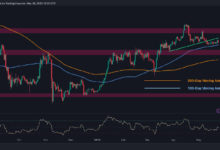Ethereum’s Vitalik Buterin May Get His Way on Ether Supply Cap — 5 Years Late

Ethereum has no formal cap on the supply of ether, but it looks to be getting an informal one thanks to the burn.
The total ether supply is now projected to have peaked in March at 120.5 million ETH, and has declined by about 100,000 ETH since then, according to data from Ultrasound Money.
Some observers note the historical irony of that 120 million number; Ethereum co-founder Vitalik Buterin proposed it as a hard cap back in April 2018. To be fair, it was the first day of April, and Buterin confessed the following day that his suggestion was an April Fools’ prank of sorts — though he did intend to encourage a very real debate on the subject.
Still — joke or not — Buterin’s suggestion was generally dismissed on the merits, as unhelpful and unworkable.
At the time, the circulating supply of ether — due to its genesis allocations and subsequent proof-of-work issuance — stood at about 98.5 million. It would be 32 more months before long-term holders could start locking 32 ETH in the Beacon Chain’s validator deposit contract, and longer still before the London hard fork introduced the concept of burning a portion of Ethereum transaction fees with EIP-1559.
A year later, the Merge further bent the curve of ether supply towards deflation, as it instantly reduced the rate of issuance — the supply previously required, under proof-of-work, for the network to operate.

Source: Ultrasound.Money
The purpose of EIP-1559 was not to reduce transaction fees, but for them to become “more predictable and thereby make the fee estimation problem — the problem of choosing the optimal gas price for a transaction — as straightforward as possible,” according to the December 2020 research paper by Tim Roughgarden detailing the concept.
For many ether holders, the more long-term ramification, however, may be the de facto supply cap, which was considered a “side benefit” at the time of its introduction.
Buried on page 52 of the 58-page paper, Roughgarden wrote, “because burned fees are effectively a lump sum refund to ETH holders, the value of ETH would be tied directly to the intensity of network usage.”
Three and a half years later, the price is about half what it was when the network’s London hard fork took effect near the height of the previous bull market euphoria. But ether’s supply has been undergoing deflation for 5 months straight, fueled by all kinds of network usage, from rollups to meme tokens.
On top of that, the amount of ether staked has been trending steadily higher, reaching an all-time high Thursday, with upwards of 566,000 validators.
Around 3,100 metric tons of gold will be mined in 2023, resulting in between 2-3% supply inflation.
Bitcoin’s inflation rate stands at 1.74%. Ether’s supply, meanwhile, has fallen 1.07% since the burn began.






 Bitcoin
Bitcoin  Ethereum
Ethereum  Tether
Tether  USDC
USDC  TRON
TRON  Dogecoin
Dogecoin  Cardano
Cardano  Bitcoin Cash
Bitcoin Cash  Chainlink
Chainlink  Monero
Monero  LEO Token
LEO Token  Stellar
Stellar  Zcash
Zcash  Litecoin
Litecoin  Hedera
Hedera  Dai
Dai  Cronos
Cronos  Tether Gold
Tether Gold  OKB
OKB  Ethereum Classic
Ethereum Classic  KuCoin
KuCoin  Gate
Gate  Algorand
Algorand  Cosmos Hub
Cosmos Hub  VeChain
VeChain  TrueUSD
TrueUSD  Dash
Dash  Tezos
Tezos  Stacks
Stacks  IOTA
IOTA  Basic Attention
Basic Attention  Theta Network
Theta Network  Decred
Decred  NEO
NEO  Synthetix
Synthetix  Qtum
Qtum  Ravencoin
Ravencoin  DigiByte
DigiByte  0x Protocol
0x Protocol  Nano
Nano  Zilliqa
Zilliqa  Holo
Holo  Siacoin
Siacoin  Numeraire
Numeraire  Waves
Waves  BUSD
BUSD  Status
Status  Pax Dollar
Pax Dollar  Enjin Coin
Enjin Coin  Ontology
Ontology  Hive
Hive  Lisk
Lisk  Steem
Steem  Huobi
Huobi  NEM
NEM  OMG Network
OMG Network  Bitcoin Gold
Bitcoin Gold  Augur
Augur  Ren
Ren  HUSD
HUSD